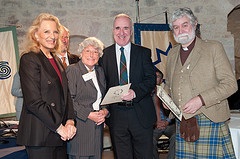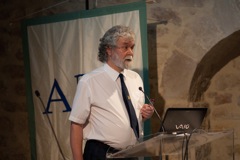|
|
|
|
 |
|
Luss, Scotland
This page has not been updated since June 2014.
Loch Lomond & The Trossachs National Park, Scotland
A founding member of the Green Pilgrimage Network
The parish of Luss, Scotland is one of nine cities and 22 different organisations and faiths that joined as founding members of the Green Pilgrimage Network, launched at Assisi, Italy, during ARC's Sacred Land Celebration, October 31-Nov 2, 2011. The founder members from Luss are:
 |
 |
 |
HRH Princess Michael of Kent, The Hon Mrs Sara Morrison, Vice President Emeritus of WWF International, James Fraser of Visit Scotland and Rev Dane Sherrard, minister of Luss in the Loch Lomond and the Trossachs National Park, Scotland, at a ceremony commemorating the pilgrim site of Luss, Scotland becoming a founder member of the Green Pilgrimage Network. |
Luss parish, Church of Scotland
Luss in the Loch Lomond and The Trossachs National Park, Scotland
The ancient settlement of Luss sits on the banks of Loch Lomond – Britain’s largest inland lake – and it lies within Scotland' s first national park, the Trossachs National Park.
Luss has been a place of Christian pilgrimage for one thousand, five hundred years. St Kessog preached here and died at the hands of Druids in the year 510.
 |
 |
 |
Rev Dane Sherrard, minister of Luss Parish, Church of Scotland, addressing the Sacred Land conference of the Green Pilgrimage Network in Assisi, 2011. |
Green Pilgrimage Actions
As founding members of the Green Pilgrimage Network, the Trossachs National Park has:
produced a new National Park Plan to continue its work on conservation of wildlife and habitats. It includes creating a sustainable traffic system for all the paths and roads used by pilgrims and visitors, as well as a commitment to work with local community initiatives to make pilgrim accommodation and businesses more eco-friendly and faith consistent.
It also includes improving waste and rubbish disposal.
A new youth project plans to involve young people from across the world to build a pilgrimage pathway along the banks of Loch Lomond.
And it’s planned that the example set by Luss will be followed by people all along the network of pilgrimage pathways crossing Scotland, which will be supported by the Scottish Government and local authorities.
Green Pilgrimage news from Luss
FEBRUARY 2012 The Reverend Dane Sherrard, minister of Luss Parish, Church of Scotland, reported meetings with Michael Russell, the Scottish Education Minister, as well as local Member of the Scottish Parliament Jackie Baillie MSP who has arranged for the Rev Sherrard to address the Parliament itself. There will be workshop presentations about Luss at the annual Eco Congregation Scotland event in April 2012 when Stewart Stevenson, Minister for Climate Change, will be present and he has also indicated that he will be accepting an invitation to visit Luss.
Representatives of Luss are going out to speak to lots of groups about being a Green Pilgrimage City, including a meeting of Scottish Tourist Guides who were fascinated and enthused, and a Scottish Pilgrimage website is being constructed to spread information about new pilgrimage opportunities.
The Rev Sherrard is most excited about local developments, however, with a community conference in Luss planned to bring together the local council, school, businesses and the church to consider all the ways they need to adapt as a community to become a truly Green Pilgrimage place.
Useful links
Download the full Green Pilgrimage Network handbook here
Visit the Lush parish website here
Visit the Loch Lomond and The Trossachs National Park website here
|
 |
|
|
|
|
|
 |
Christian Faith Statement
A formal statement of Christian beliefs about creation and ecology: "Are not five sparrows sold for two pennies? Yet not one of them is forgotten by God." |
 |
ARC and the Faiths
Faith communities are working in countless ways to care for the environment. This section outlines the basics of each faith’s history, beliefs and teachings on ecology. |
 |
ARC at a glance
ARC is a secular body that helps the major religions of the world to develop their own environmental programmes, based on their own core teachings, beliefs and practices. |
 |
 |
|
|

